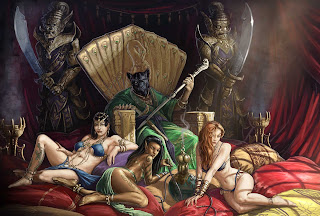Rakshasas are one of D&D/Pathfinder’s
iconic monsters. That means that your players known exactly each one of its
strengths and vulnerabilities (which, by the way, sucks). Like trolls, I love
to change classic monsters traits – in part because I like to teach my players
that metagame knowledge is not something suited for every game (though fine for
others); in part because in legends rakshasa are represented by amazingly
different types of monsters (from brute cannibal ogres to a beautiful nymphs).
In my Curse
of the Crimson Throne campaign I came up with two house rules for my
rakshasas. The first is a random table that defines a rakshasa’s weakness (DR).
Instead of being vulnerable to ‘good and piercing’ weapons a rakshasa could,
for example, be damaged by ‘holy water and piercing’.
Rakshasa Damage Reduction (d8)1 . Good and piercing.2 . Holy water and piercing.3 . Salt and piercing.4 . Silver and piercing.5 . Fire and piercing.6 . Wielded by a good priest.7 . The song of a brass bell [at my game I gave this vulnerability to the Rakshasa Leader].8 . Roll again.
Finally, I gave to each rakshasa one of the
abilities below, based on its animal head.
Vulture-head (“Plague Demon”): claw attacks inflict disease and once per combat he can breathe a wasp swarm.Orangutan- head (“Strength Demon”): the rakshasa gains what I call ‘subjective strength’. It gains a gaze attack. If the target fails at a Will save, he always fails opposed Strength-based checks (and Combat Maneuver rolls) against the rakshasa [at my game this rakshasa always attacked through grapple, the only way to get free was to use Escape Artists or to stun the demon].Lizard- head (“Scale-folk Demon”): the rakhsasa’s tongue is a living serpent with a poison attack.Boar- head (“Fire Demon”): this rakshasa gets hotter the longer he fights. After 1 round of combat, any natural attack (or unarmed or grapple) that hits it deals 1d6 fire damage to the attacker. At the 3rd round, the heat is so intense that anyone at 5 feet of the rakshasa suffers 1d4 points of fire damage per round (increasing by 1d4 every 2 rounds, to a maximum of 5d4).
The Tiger-head Rakshasa was already the
encounter’s boss, with a lots of class levels, so I let him as stated (though I
gave him DR that can only be ignored by the sound of a brass bell).
[Ah, in
the campaign the combat against the rakhsasas was one of the hardest and by far
the most memorable ones. The PCs eventually won, but tide of battle changed a lot
during the encounter – there were moments where only one or two (of a total of
4 players) were standing. The battle put 5 rakhsasas, 2 asura and 1 aberration
against 4 PCs and 2 NPCs (both already wounded). The best part? The rakshasa master
managed to escape (without one eye due to a cool critical hit from this
Pathfinder Deck), to orchestrate his revenge – a perfect conclusion for me.]



No comments:
Post a Comment